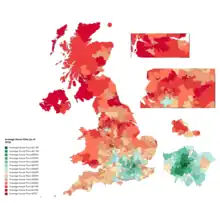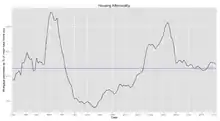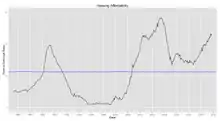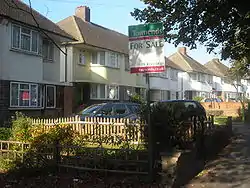Affordability of housing in the United Kingdom
The affordability of housing in the UK reflects the ability to rent or buy property. There are various ways to determine or estimate housing affordability. One commonly used metric is the median housing affordability ratio; this compares the median price paid for residential property to the median gross annual earnings for full-time workers. According to official government statistics, housing affordability worsened between 2020 and 2021, and since 1997 housing affordability has worsened overall, especially in London. The most affordable local authorities in 2021 were in the North West, Wales, Yorkshire and The Humber, West Midlands and North East.[1]

Housing tenure in the UK has the following main types: Owner-occupied, private rented sector (PRS), and social rented sector (SRS).[2] The affordability of housing in the UK varies widely on a regional basis – house prices and rents will differ as a result of market factors such as the state of the local economy, transport links, and the supply of housing.
Key determinants of affordability
For owner-occupied properties, key determinants of affordability are house prices, income, interest rates, and purchase costs. For rented property, PRS rents will largely be a reflection of house prices, while SRS rents are set by Local Authorities, Housing Associations or similar.[3][4][5]
House prices
Land Registry figures for England and Wales show that housing prices rose from £70,000 to £224,000 in the 20 years between 1998 and 2018.[6] Growth was almost continuous during the period, save for two years of decline around 2008 as a result of the banking crisis.[7]
House price averages compared to average salary


The gap between average income and average housing prices changed between 1985 and 2015 from twice an average salary to up to six times average income. Median house prices in London the median house now cost up to 12 times the median London salary. In 1995, the median house price was £83,000, 4.4 times the median income. By 2012–13, the median income in London had increased to £24,600 and the median London house price had increased to £300,000, 12.2 times median income[8]
In 1995, the Bank base rate was 6%, in March 2009 it stood at 0.5% until August 2016 when it was further reduced to 0.25%.[9]
Effect of planning restrictions on house prices

An analysis by the LSE and the Dutch Bureau for Economic Policy Analysis found that house prices in England would have been 35% cheaper without regulatory constraints.[10] A report by the Adam Smith Institute found that by using 4% of London's green belt, one million homes could be built within a 10-minute walk of a railway station.[11]
The Economist has criticised green belt policy, saying that unless more houses are built through reforming planning laws and releasing green belt land, then housing space will need to be rationed out. It noted that if general inflation had risen as fast as housing prices had since 1971, a chicken would cost £51; and that Britain is "building less homes today than at any point since the 1920s".[12] According to the independent Institute of Economic Affairs, there is "overwhelming empirical evidence that planning restrictions have a substantial impact on housing costs" and are the main reason why housing was two and a half times more expensive in 2011 than it was in 1975.[13]
The Campaign to Protect Rural England argued that "Green Belt land is important for our wider environment, providing us with the trees and the undeveloped land which reduce the effect of the heat generated by big cities. Instead of reducing this green space, we should be using it to its best effect. We know from our research that three-quarters (79%) of the population would like to see more trees planted and more food grown in the areas around towns and cities."[14]
Valuation of land and effect on house prices

Property companies state that land values follow house prices and that a developer assesses what new build house price is achievable in any particular location with reference to prices and sales rates in the second-hand market and on nearby comparable new build sites. At a basic level (assuming no affordable housing, S106 or CIL), they then multiply that new build house price by the number of homes to be built on the land and to arrive at the gross development value (GDV) of the site. The underlying value of the land is then the GDV less the cost of development and less an allowance for profit.[16]
According to a study by Knoll, Schularick and Steger, up to 80% of the rise in houses prices between 1950 and 2012 can be attributed to the increasing price of land.[17][18] This is for two reasons. Firstly, before 1950 improving transport meant that more and more land was economically usable, but this effect subsided after 1950. Secondly, zoning restrictions did not allow the "utilisation of additional land".[17]
In 2015, the Department for Communities and Local Government shared the land value estimates for residential land, agricultural land and industrial land. It found that the average price of a typical agricultural plot was £21,000.[19]
Property costs
The principal taxes imposed by the central government are Stamp Duty and Value Added Tax (VAT). Other costs which are associated with the buying and selling of property are estate agent fees, conveyancing and survey fees, mortgage arrangement fees (where applicable), and removal costs.[20]
Stamp Duty Land Tax
Stamp Duty Land Tax is payable on property transactions in England and Northern Ireland. Tax is paid at different rates on different portions of the purchase price. For example, on a £600,000 house, no tax is paid on the first £250,000, and the portion (£350,000) in the £250,000-£925,000 tax band is charged at 5%, i.e. £17,500. This gives a total tax of £17,500.
| Purchase price of property | Rate of SDLT on portion of purchase price |
|---|---|
| £40,000 - £250,000 | 0% |
| £250,001 to £925,000 | 5% |
| £925,001 to £1,500,000 | 10% |
| Over £1,500,000 | 12% |
Scotland and Wales apply their own tax to property transactions, replacing the Stamp Duty Land Tax. Scotland introduced the Land and Buildings Transaction Tax in 2015, and Wales introduced the Land Transaction Tax in 2018.
Estate Agent fees
In 2011, Which? magazine found the national average estate agents' fees to be 1.8%.[21] But fees can range between 0.75% to 3% depending on where you are in the UK.[22]
Survey
There are four main types of survey: a valuation survey, a condition report, a homebuyer report and a full structural survey.[23]
Legal fees
Conveyancing fees vary according to the value of the property and the service provided.[24]
Mortgage arrangement fees
In April 2013, The Daily Telegraph reported that research by Moneyfacts showed the average mortgage arrangement fee to be £1522.[25]
Housing Shortage
In 2020, the BBC reported the UK's housing gap was in excess of one million homes,[26] and previously (in 2019) that "An estimated 8.4 million people in England are living in an unaffordable, insecure or unsuitable home, according to the National Housing Federation".[27] Unaffordable housing is defined by the Affordable Housing Commission as to where housing costs are above 30% of household income.[28] In a government briefing paper, 'Tackling the under-supply of housing in England',[29] Barton and Wilson describe England's housing need as being illustrated by issues "such as increased levels of overcrowding, acute affordability issues, more young people living with their parents for longer periods, impaired labour mobility resulting in businesses finding it difficult to recruit and retain staff, and increased levels of homelessness".[29]
Despite an added 244,000 homes to England's housing stock in 2019/20, the notion that an increased supply of housing will improve affordability has been challenged: the UK Housing Review (September 2017) states, "Indeed as the evidence to the Redfern Review from Oxford Economics reminds us, it is unlikely to bring house prices down except in the very long term and with sustained high output of new homes relative to household growth. Even boosting (UK) housing supply to 310,000 homes per annum in their model only brings a five per cent fall in the baseline forecast of house prices".[30] Therefore, the National Housing Federation (NHF) and Crisis from Heriot-Watt University argue that alongside the needed 340,000 new homes each year (until 2031), 145,000 of those “must be affordable homes”.[29][31]
Other factors affecting affordability
Council Tax
The Joseph Rowntree Foundation has suggested replacing the current Council tax system based on bands of house prices with a system that would mean the tax was more closely related to property prices. This would increase taxes on the highest-priced properties and decrease them for the lowest. They claim it would also have the effect of reducing house price volatility.[32]
Land value tax is suggested by some as a replacement for council tax; it would be based entirely on land (i.e. location) value and not on the value of buildings built on a piece of land or improvements made.[33][34][35]
International investment demand
In 2015, the Bow Group, a conservative think-tank, produced a report suggesting a reduction in international investment demand of property. The report proposed limiting foreign residents to the purchase of single new-build properties, with penalties if sold within five years.[36] In 2016, London mayor Sadiq Khan launched an inquiry into housing costs in the city, also highlighting the effect of foreign investment.[37]
Second home ownership
The government set up a £60 million fund to help councils deal with high levels of second home ownership.[38] In 2016, a referendum in St Ives, Cornwall found 83.2% of voters in favour of new housing projects being reserved for full-time residents, as many tourists frequent the area and Cornwall is popular for second home and holiday property ownership.[39]
Buy-to-let tax changes
From April 2016, a Stamp Duty surcharge of three per cent of the purchase price was required for those buying to let. From April 2017, buy-to-let mortgage interest payments will have higher rates of income tax relief phased out by the government.[40] Although, companies would not be affected by the new rules.[41]
Rented homes
The English Housing Survey Bulletin 13[42] states that in 2013/14 there were 4.4 million households in the private rented sector and 3.9 million households in the social rented sector, of whom 2.3 million households (10%) were renting from a housing association and 1.6 million (7%) were renting from a local authority. Private renters had the highest weekly housing costs, paying on average £176 per week in rent. Mortgagors paid an average of £153 per week in mortgage payments while mean weekly rents in the social housing sector were £98 for housing association tenants and £89 for local authority tenants. When considering the gross weekly income, including benefits, of all household members, the proportion of income spent on housing costs was 18% for mortgagors, 29% for social renters, and 34% for private renters.
London
The demand for more affordable housing has often been even higher in London than in the rest of the UK.[43] Research from Trust for London found that 24% of new housing completions in the three years to 2015/16 were affordable, which represented 21,500 homes. 6,700 affordable homes were completed in 2015/16, which is just 39% of the target set in the 2015 London Plan.[44] They also found that the amount of affordable homes being built varies significantly between the London Boroughs. Tower Hamlets delivered 1830 affordable homes in the three years to 2015/16, the most in London, while Bexley only delivered 7, the fewest in London.[45] Affordable housing is defined as housing that costs no more than 80% of the average local market rent.[46]
See also
References
- "Housing affordability in England and Wales: 2021 - Office for National Statistics". www.ons.gov.uk. Retrieved 15 June 2022.
- "EHS 2013–14 Annual Reports published" (PDF). English Housing Survey Bulletin. No. 13. Retrieved 10 October 2017.
- "Analysis of the determinants of house price changes" (PDF). Ministry of Housing, Communities and Local Government. 13 April 2018. Archived (PDF) from the original on 4 July 2021. Retrieved 18 July 2021.
- "Rent setting: social housing (England)". House of Commons Library. Archived from the original on 2 June 2020. Retrieved 18 July 2021.
- "Housing affordability in England and Wales: 2016". Office for National Statistics. 17 March 2017. Archived from the original on 19 May 2021. Retrieved 18 July 2021.
- "House Price Statistics (from May 1998 to May 2018)".
- "Land Registry - search the house price index". Landregistry.data.gov.uk. Retrieved 6 January 2016.
- "The widening gulf between salaries and house prices". Theguardian.com. Retrieved 6 January 2016.
- "Bank of England Statistical Interactive Database | Interest & Exchange Rates | Official Bank Rate History". Bankofengland.co.uk. Retrieved 7 March 2016.
- "Why UK house prices have grown faster than anywhere else". Telegraph.co.uk. Retrieved 6 January 2016.
- "Green belt a "green noose", claims Adam Smith Institute". Environmentsite.com. Retrieved 6 January 2016.
- "Build on the green belt or introduce space rationing: your choice", Economist.com, retrieved 6 January 2016
- Kristian Niemietz (April 2012). "Abundance of land, shortage of housing : IEA Discussion Paper No. 38" (PDF). Iea.org.uk. Retrieved 6 January 2016.
- "Green Belts: breathing spaces for people and nature - Campaign to Protect Rural England". Cpre.org.uk. Retrieved 6 January 2016.
- "The UK national balance sheet: 2017 estimates". Ons.gov.uk. Retrieved 8 January 2018.
- "Savills UK | The value of land". Savills.co.uk. Retrieved 6 January 2016.
- Katharina Knoll; Moritz Schularick; Thomas Steger (1 November 2014). "Home prices since 1870: No price like home". Archived from the original on 11 June 2021. Retrieved 18 July 2021.
- Josh Ryan-Collins. "How Land Disappeared from Economic Theory". Evonomics. Archived from the original on 9 June 2021. Retrieved 18 July 2021.
- "February 2015 Department for Communities and Local Government Land value estimates for policy appraisal" (PDF). Government of the United Kingdom. 2 February 2015. Retrieved 14 October 2021.
- "House Moving Costs". GetAgent.
- "Estate agents' fees exposed - March - 2011 - Which? News". Which.co.uk. 31 March 2011. Retrieved 23 September 2012.
- "Estate Agent Fees". GetAgent. Retrieved 15 June 2021.
- "What sort of property survey should you go for?". MoneySupermarket.com. 18 July 2011. Retrieved 29 December 2015.
- Choosing a conveyancer in 2013 by Graham Norwood in The Guardian, 15 February 2013. Retrieved 18 September 2013.
- Mortgage fees climb to new high Jessica Winch, The Telegraph, 9 April 2013. Retrieved 12 October 2013. Archived here.
- "Housing shortage: Scale of UK's housing gap revealed". BBC News. 23 February 2020. Retrieved 6 May 2021.
- "Housing crisis affects estimated 8.4 million in England - research". BBC News. 22 September 2019. Retrieved 7 May 2021.
- "Defining and measuring housing affordability – an alternative approach" (PDF). Nationwide Foundation.
- Barton, Cassie; Wilson, Wendy (5 July 2021). "Tackling the under-supply of housing in England".
{{cite journal}}: Cite journal requires|journal=(help) - Stephens, Mark; Wilcox, Steve; Williams, Peter; Perry, John (2017). "2017 UK Housing Review Briefing" (PDF). Chartered Institute of Housing: 22.
- Bramley, Glen (April 2019). Housing supply requirements across Great Britain for low-income households and homeless people: Research for Crisis and the National Housing Federation; Main Technical Report. Heriot-Watt University. doi:10.17861/bramley.2019.04. ISBN 978-1-9161385-0-6.
- "After the Council Tax: impacts of property tax reform on people, places and house prices".
- Webb, Merryn (27 September 2013). "How a levy based on location values could be the perfect tax". Financial Times. Retrieved 14 May 2015.
- "Why Henry George had a point". The Economist. Retrieved 29 June 2017.
- Smith, Adam (1776). The Wealth of Nations, Book V, Chapter 2, Article I: Taxes upon the Rent of Houses.
Ground-rents are a still more proper subject of taxation than the rent of houses. A tax upon ground-rents would not raise the rents of houses. It would fall altogether upon the owner of the ground-rent, who acts always as a monopolist and exacts the greatest rent which can be got for the use of his ground.
- Collinson, Patrick (21 November 2015). "Is it time to close the door to foreign buyers of British property?". The Guardian. Retrieved 22 February 2017.
- Taylor, Matthew; Phillips, Tom (30 September 2016). "London mayor launches unprecedented inquiry into foreign property ownership". The Guardian. Retrieved 22 February 2017.
- "Fund launched to tackle second home ownership problem". Archived from the original on 12 June 2018. Retrieved 18 July 2021.
- "St Ives referendum: Second homes ban backed by voters". BBC News. 6 May 2016. Retrieved 22 February 2017.
- Giles, Chris (6 April 2016). "New rules will do little to quell buy-to-let boom". FT. Retrieved 22 February 2017.
- Whiscombe, David (2 September 2015). "Squeeze on buy to let". Taxation. Retrieved 22 February 2017.
- "English housing survey bulletin: issue 13". Gov.uk. Retrieved 8 January 2018.
- "Changes to affordable housing in London and implications for delivery". Joseph Rowntree Foundation. Retrieved 7 June 2018.
- "London's Poverty Profile". Trust for London. Retrieved 7 June 2018.
- "London's Poverty Profile 2017". Trust for London. Retrieved 8 February 2018.
- "Reality Check: What is affordable housing?". BBC News. Retrieved 23 May 2019.